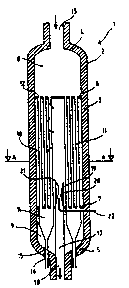Some of the information on this Web page has been provided by external sources. The Government of Canada is not responsible for the accuracy, reliability or currency of the information supplied by external sources. Users wishing to rely upon this information should consult directly with the source of the information. Content provided by external sources is not subject to official languages, privacy and accessibility requirements.
Any discrepancies in the text and image of the Claims and Abstract are due to differing posting times. Text of the Claims and Abstract are posted:
| (12) Patent: | (11) CA 2063605 |
|---|---|
| (54) English Title: | APPARATUS AND A METHOD FOR SEPARATING PARTICULATE MATERIAL FROM HIGH-TEMPERATURE GASES |
| (54) French Title: | APPAREIL SERVANT A LA SEPARATION DE MATERIAUX PARTICULAIRES CONTENUS DANS DES GAZ HAUTE TEMPERATURE ET METHODE CONNEXE |
| Status: | Expired and beyond the Period of Reversal |
| (51) International Patent Classification (IPC): |
|
|---|---|
| (72) Inventors : |
|
| (73) Owners : |
|
| (71) Applicants : |
|
| (74) Agent: | GOWLING WLG (CANADA) LLP |
| (74) Associate agent: | |
| (45) Issued: | 1993-10-26 |
| (86) PCT Filing Date: | 1990-07-06 |
| (87) Open to Public Inspection: | 1991-01-13 |
| Examination requested: | 1992-01-10 |
| Availability of licence: | N/A |
| Dedicated to the Public: | N/A |
| (25) Language of filing: | English |
| Patent Cooperation Treaty (PCT): | Yes |
|---|---|
| (86) PCT Filing Number: | PCT/FI1990/000179 |
| (87) International Publication Number: | FI1990000179 |
| (85) National Entry: | 1992-01-10 |
| (30) Application Priority Data: | ||||||
|---|---|---|---|---|---|---|
|
2063605 9100769 PCTABS00003
In accordance with the present invention, there is provided a
filter housing (2) comprising a plurality of open-ended parallel
hollow gas-permeable filter elements (11) for separating particulate
material from a high-temperature gas. The filter housing
comprises at least a pair of cross sectional support plates (6, 7)
dividing the filter housing into a first end section (8) having an
inlet (13) for dirty gas, a end second section (9) in connection
with a discharge port (16) for separated particulate material, and
an intermediate filtration chamber (10, 24, 24, 29, 30, 31, 41,
42) section therebetween. The filter elements are arranged in the
intermediate filtration chamber extending from the first support
plate to the second support plate. A clean gas outlet conduit (17,
26, 27, 32, 33, 34, 37, 38, 43, 44) is in communication with the
clean gas space in the intermediate filtration chamber. It is an
important feature of the present invention that means (22) are
provided inside said filter housing for supplying a reverse flow
pressure pulse of high energy gas into said filtration chamber,
for cleaning the porous filter medium. The reverse-flow pressure
pulse can be supplied through a relatively small pipe connected to
a compressor.
Note: Claims are shown in the official language in which they were submitted.
Note: Descriptions are shown in the official language in which they were submitted.

2024-08-01:As part of the Next Generation Patents (NGP) transition, the Canadian Patents Database (CPD) now contains a more detailed Event History, which replicates the Event Log of our new back-office solution.
Please note that "Inactive:" events refers to events no longer in use in our new back-office solution.
For a clearer understanding of the status of the application/patent presented on this page, the site Disclaimer , as well as the definitions for Patent , Event History , Maintenance Fee and Payment History should be consulted.
| Description | Date |
|---|---|
| Inactive: IPC from MCD | 2006-03-11 |
| Inactive: IPC from MCD | 2006-03-11 |
| Time Limit for Reversal Expired | 2000-07-06 |
| Letter Sent | 1999-07-06 |
| Grant by Issuance | 1993-10-26 |
| Request for Examination Requirements Determined Compliant | 1992-01-10 |
| All Requirements for Examination Determined Compliant | 1992-01-10 |
| Application Published (Open to Public Inspection) | 1991-01-13 |
There is no abandonment history.
| Fee Type | Anniversary Year | Due Date | Paid Date |
|---|---|---|---|
| MF (patent, 7th anniv.) - standard | 1997-07-07 | 1997-06-16 | |
| MF (patent, 8th anniv.) - standard | 1998-07-06 | 1998-06-15 |
Note: Records showing the ownership history in alphabetical order.
| Current Owners on Record |
|---|
| FOSTER WHEELER ENERGIA OY |
| Past Owners on Record |
|---|
| DAVE B. RUSSELL |
| JUHANI ISAKSSON |